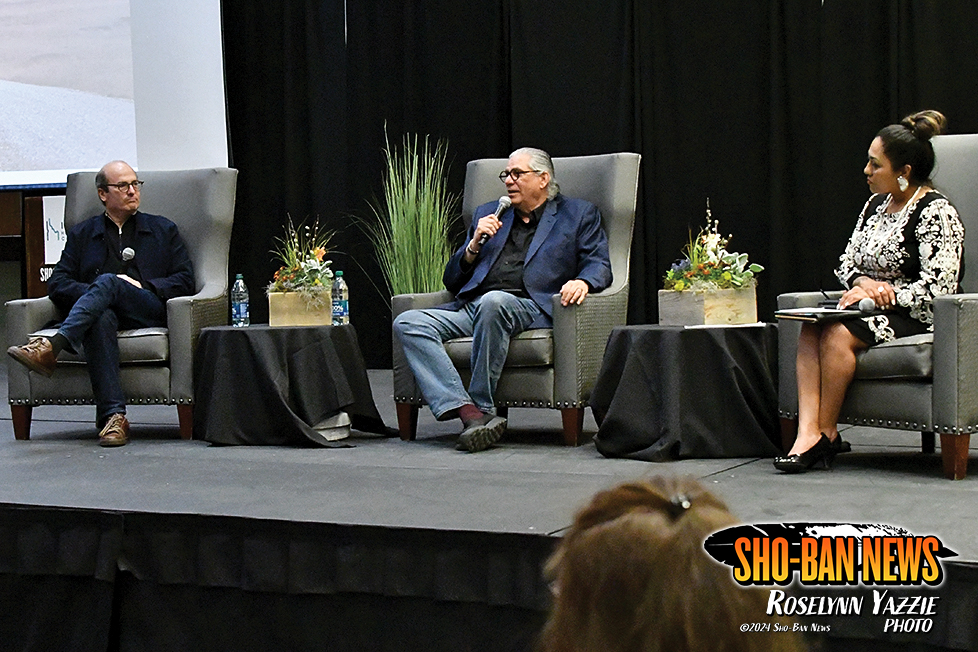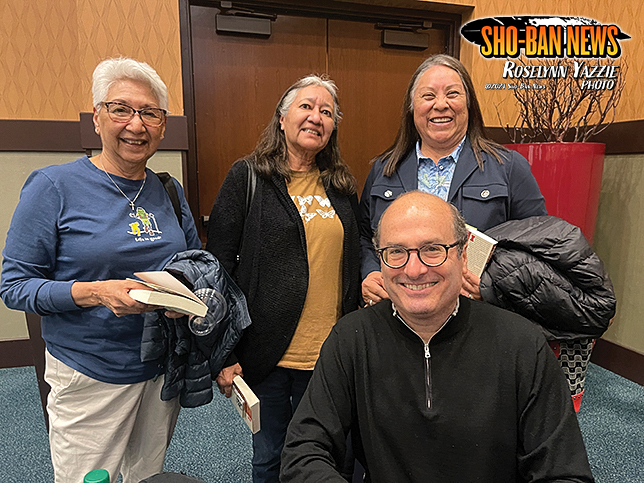‘Killers of the Flower Moon’ author receives Sho-Ban welcome during Distinguished Humanities Lecture

Sho-Ban tribal member author and journalist Mark Trahant is featured on a panel with Grann and tribal author Randy’L Teton on April 18.
By ROSELYNN YAZZIE
Sho-Ban News
FORT HALL — The 15th Annual Eastern Idaho Distinguished Humanities Lecture with “Killers of the Flower Moon” author David Grann, was on Thursday, April 18 at the Shoshone-Bannock Hotel & Event Center.
The Idaho Humanities Council’s mission is to provide opportunities to deepen public understanding of human experience by connecting people with ideas. The vision of the IHC is that the humanities inspire a more literate, tolerant, and intellectually inquisitive Idaho citizenry, better able to embrace life’s possibilities.
Grann was welcomed by Idaho Humanities Council Chair Shelley McEuen-Howard; members of the Fort Hall Business Council, Chairman Lee Juan Tyler and Secretary Claudia Washakie; Ghost Canyon Singers, and Shoshone-Bannock Dance Troupe.
Fort Hall Business Council Chairman Lee Juan Tyler shared the history of the Shoshone-Bannock people with a well-attended audience.
FHBC Secretary Claudia Washakie has a true appreciation for the literature getting exposure to the issues in Indian Country that have happened for many generations, such as missing and murdered Indigenous people and on May 5 a nationwide proclamation is signed to address MMIP issues. She asked the audience to wear red on that day to stand in solidarity with the occasion. This epidemic hits home for her in the case of her missing nephew.

Author David Grann signs books for community.
Grann took the stage to a round of applause and spoke about his experiences in writing his best-selling book, which began with a trip in 2012 to the Osage Nation Museum.
A 1924 photograph on the wall with Osage members and White settlers piqued his interest. He saw a portion of it was missing and he asked the museum director what happened to it.
“She said it contained a figure so frightening that she had decided to remove it. And she then pointed to the missing panel and I’ll never forget this, she said, ‘The devil was standing right there.’”
The book grew out of that, to tell the story of what he describes as one of the most sinister crimes in American history. To understand those crimes, which took place in the early parts of the 20th century one needs to understand members of the Osage Nation were all extraordinarily wealthy because of all the oil deposits on their land.
In 1923, 2,000 Osage members received the equivalent of what would be worth today to more than $400 million. They were considered among the wealthiest people per capita in the world.
The book tells of the murders of the Osage for their lands and wealth and the beginning of the FBI who investigated the case of killings and money in Mollie Burkhart’s family. Eventually leading to her husband Ernest Burkhart who would ultimately benefit from the deaths along with William K. Hale.
Grann decided to tell the story from Mollie’s perspective as it’s often left out of all the official records.
Grann explained so many people were never taught this history.
“We excised it from our consciousness and our conscience and hopefully we can now at least, begin to restore some of our past and in the process hopefully learn about the kind of people and the nation we want to be in the future,” said Grann.
Grann joined a panel including Shoshone-Bannock tribal members, editor at large for Indian Country Today, and author Mark Trahant, along with moderator and “It’s Her Story: Sacajawea,” author Randy’L Teton.
Trahant said this story was harsh for the Osage and unbelievably brutal but was also one repeated throughout Indian Country, such as what happened with the White Earth Nation in Minnesota. He mentioned Camas Prairie and how it was lost because it was allegedly misspelled as Kansas Prairie in the Fort Bridger Treaty. One from his family involves the land the Pocatello Airport sits on which was sold to the city for $1.
“Killers of the Flower Moon” was also turned into a film by Martin Scorsese, starring Oscar-nominated actress Lily Gladstone (Blackfeet) and Leonardo DiCaprio. Teton asked Grann if he saw it and what his thoughts were.
He replied, that he never thinks about a book and a movie as the same thing because there are places you can’t go in a book that you can in a movie, for example, the bedroom. However, he thought they did a remarkably good job with the film because they worked with the Osage Nation.
Grann hopes that people see the movie, read the book, and read the works of other Osage and Indigenous authors to learn more from them.
Trahant and Grann were asked about their upcoming projects. Trahant talked about his forthcoming book on Native women leaders and how he has decided to write it for young adults in hopes of inspiring future generations. Grann didn’t disclose too much about his upcoming work other than it will deal with espionage.
One of the questions from the crowd was has Grann been told that Osage history was not his story to tell? Grann answered he’s not a memoirist, but a reporter and writer. He tells a story for better or for worse and everyone has roles in society to play and he thinks of himself as an ally. He told the stories for the Osage elders who wanted him to document it as he spent six years interviewing the Osage people. It was experience he will always remember.
Grann said history is a process of many people and perspectives. We learn by a collection of stories.
Many fans lined up for an hour patiently waiting for Grann to sign their book.
Grann said, “What a reception with the drummers and the singers and the dancers. That was like the greatest thing ever. It was a really special event.”
He said trips like these not only allow him to share some of the research in his book, but in turn, he gets to learn.
“Tonight was one of those special nights where you feel like you’re learning and you’re learning from others,” said Grann.





